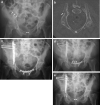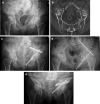Operative treatment of fragility fractures of the pelvis: a critical analysis of 140 patients
- PMID: 34635938
- PMCID: PMC9360165
- DOI: 10.1007/s00068-021-01799-6
Operative treatment of fragility fractures of the pelvis: a critical analysis of 140 patients
Abstract
Background: Fragility fractures of the pelvis (FFP) are a clinical entity with an increasing frequency. Indications for and type of surgical treatment are still a matter of debate.
Purpose: This retrospective study presents and critically analyses the results of operative treatment of 140 patients with FFP.
Setting: Level-I trauma center.
Materials and methods: Demographic data, comorbidities, FFP-classification, type of surgical stabilization (percutaneous (P-group) versus open procedure (O-group)), length of hospital stay (LoS), general in-hospital complications, surgery-related complications, living environment before admission, mobility and destination at discharge were retracted from the medical and radiographic records. Patients were asked participating in a survey by telephone call about their quality of life. SF-8 Physical Component Score (PCS) and SF-8 Mental Component Score (MCS) were calculated as well as the Parker Mobility Score (PMS) and the Numeric Rating Scale (NRS).
Results: Mean age was 77.4 years and 89.3% of patients were female. 92.1% presented with one comorbidity, 49.3% with two or more comorbidities. Median length of hospital stay was 18 days, postoperative length of hospital stay was 12 days. 99 patients (70.7%) received a percutaneous operative procedure, 41 (29.3%) an open. Patients of the O-group had a significantly longer LoS than patients of the P-group (p = 0.009). There was no in-hospital mortality. There were significantly more surgery-related complications in the O-group (43.9%) than in the P-group (19.2%) (p = 0.006). Patients of the O-group needed more often surgical revisions (29.3%) than patients of the P-group (13.1%) (p = 0.02). Whereas 85.4% of all patients lived at home before admission, only 28.6% returned home at discharge (p < 0.001). The loss of mobility at discharge was not influenced by the FFP-classes (p = 0.47) or type of treatment (p = 0.13). One-year mortality was 9.7%. Mortality was not influenced by the FFP-classes (p = 0.428) or type of treatment (p = 0.831). Median follow-up was 40 months. SF-8 PCS and SF-8 MCS were moderate (32.43 resp. 54.42). PMS was 5 and NRS 4. Follow-up scores were not influenced by FFP-classes or type of treatment.
Conclusion: Patients with FFP, who were treated operatively, suffered from a high rate of non-lethal general, in-hospital complications. Open surgical procedures induced more surgery-related complications and surgical revisions. Mental and physical follow-up scores are low to moderate. Condition at follow-up is not influenced by FFP-classes or type of treatment. Indications for operative treatment of FFP must be critically examined. Surgical fixation should obtain adequate stability, yet be as less invasive as possible. The advantages and limitations of different surgical techniques have to be critically evaluated in prospective studies.
Keywords: Complications; Fragility fracture; Mortality; Open; Operative; Outcome; Pelvis; Percutaneous.
© 2021. The Author(s).
Conflict of interest statement
The authors declare that they have no conflict of interest.
Figures



References
-
- Andrich S, Haastert B, Neuhaus E, Neidert K, Arend W, Ohmann C, Grebe J, Vogt A, Jungbluth P, Rösler G, Windolf J, Icks A. Epidemiology of pelvic fractures in Germany: considerably high incidence rates among older people. PLoS One. 2015;10(9):e0139078. doi: 10.1371/journal.pone.0139078. - DOI - PMC - PubMed
-
- Hackenbroch C, Riesner HJ, Lang P, Stuby F, Danz B, Friemert B, Palm HG, AG Becken III der Deutschen Gesellschaft für Unfallchirurgie Dual energy CT—a novel technique for diagnostic testing of fragility fractures of the pelvis. Z Orthop Unfall. 2017;155(1):27–34. doi: 10.1055/s-0042-110208. - DOI - PubMed
MeSH terms
Grants and funding
LinkOut - more resources
Full Text Sources
Medical
Miscellaneous

